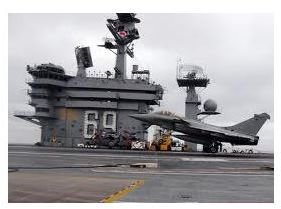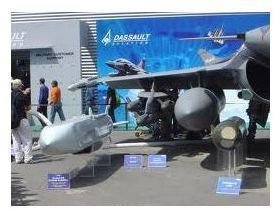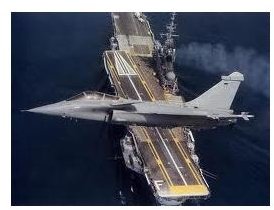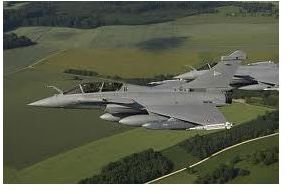The Dassault Rafale: France's Premier Combat Aircraft
Dassault’s Modern Multirole Combat Aircraft
Rising from the disastrous Second World War, Dassault Aviation was a new incarnation of Marcel Bloch’s successful aircraft design and manufacturing company started in the 1930’s. Throughout the Cold War Dassault exemplified France’s “Third Path” - an effort to stake out an identity separate from that of the monolithic blocs of NATO or the Warsaw Pact - each of which produced combat aircraft designed to defeat the others'.
The Mirage series of fighters remain, to this day, a highly capable example of what French aviation could accomplish largely independent of foreign cooperation. After dropping out of the Eurofighter consortium in the 1980’s Dassault was tasked with designing a competing aircraft that could function as a successor to the Mirage series then in French Air Force service, as well as the Super Etendard and imported Vought F-8 Crusader then in service with the French navy flying off the aircraft Clemenceau and Foch.
The Dassault Rafale was the answer.
Rafale Development
The Rafale was conceived as a fighter capable of replacing virtually every other combat aircraft in French service, and was thus required to perform a variety of roles in addition to its primary function of air to air combat. The new fighter had to be capable of tight maneuvers, accelerating to high mach numbers, and and still be able to conduct deep penetration raids into enemy territory - possibly to conduct nuclear strikes. Unlike previous generation aircraft, which tended to specialize in ground attack or air combat roles, the new airframe’s design would pose a significant challenge to Dassault. Rafale fighter jets were also required to be available in naval variants capable of carrier operations due to the advanced age of the F-8 Crusader fighters, which the United States largely retired from service after the Vietnam War.
The resulting design possessed such a wide variety of functional capabilities that Dassault markets the Rafale not simply as a multrole but an omnirole fighter. This turn of phrase exemplifies, to Dassault, the increase in capabilities of the Rafale over competing airframes.
Rafale Specifications
The resulting aircraft, deployed in the 1990s and early 2000s, boasts a balanced stat sheet that makes it a highly functional aircraft for the French military, which eventually plans to operate around 300 Dassault Rafales.
Here are some of the vital statistics on the Rafale, as published by Dassault Aviation and the French Military:
- 35.4 ft wing span, 33.8 ft length, 17.4 ft high
- Max takeoff weight 27 tons, 10,300 lb internal fuel
- 13(naval) or 14 hardpoints with ~10 ton max external load.
- 55,000 ft ceiling, 1000 nautical mile mission radius
- 83 ft squared wing loading, 1.1 thrust/weight ratio
- Two engines with afterburners capable of supercruise
- 1 30mm internal cannon with 125 rounds
- Thales Radar and SPECTRA electronic warfare system
The Rafale is capable of mounting MICA and eventually Meteor air to air missiles, Exocet anti-ship and Scalp stand off missiles, and laser guided bombs in addition to conventional unguided munitions.
Operational History, Milestones, and Limitations
The Rafale has a relatively short operational history when compared to other modern aircraft, but still more combat experience than the Typhoon or Gripen. The recent deployment to Afghanistan of several Rafales gave the French Air Force experience operating the Rafale with a combat tempo under harsh conditions. Several were flown from Tajikstan, and others from the aircraft carrier Charles de Gaulle.
While the war in Afghanistan did not see significant air to air combat, the Rafales were upgraded to carry laser guided bombs, and used them in support of Dutch forces in 2007. One downside of this deployment was that other aircraft had to carry laser designator pods in order to provide targeting information for the Rafales, because the variants then in service were not fully upgraded to provide close air support commonly called upon in Afghanistan.

One major milestone set by the Dassault Rafale was the first engine change made on a foreign fighter aircraft aboard a US Navy aircraft carrier. The Rafale has also made a number of landings aboard US aircraft carriers.
The NATO intervention in Libya beginning in March of 2011 opened a new chapter in the Rafale’s operational history. Flying from the Charles de Gaulle and airbases in France proper a Rafale was reportedly the first aircraft to attack Libyan artillery positioned outside Benghazi as part of the NATO defense of the city from Libyan regime forces.
Limitations aside, the Dassault Rafale has been seriously considered as a next generation combat aircraft by several nations.
Export Potential
While no exports have yet been made, Rafale fighter jets have been taken under serious consideration by India, Brazil, Libya, Greece, Switzerland, Morocco, Oman, Kuwait, and the United Arab Emirates.

Dassault markets the Rafale as an omnirole fighter capable of taking on virtually any role ranging from reconnaissance to aerial interception to close air support. This distinguishes the Rafale from competitors such as the Saab Gripen and EADS Eurofighter Typhoon.
Rafale fighter jets have lagged behind these competitor aircraft in securing buyers, but the Rafale continues to be evaluated by a number of major air forces, and was even for a time considered by Britain as a possible alternative to its planned purchase of the US F-35 for the Royal Navy’s new Queen Elizabeth class aircraft carriers.
The Rafale and the Indian M-MRCA
The Indian M-MRCA competition (Medium Multirole Combat Aircraft) has been underway for several years while the Indian Air Force evaluates a number of contemporary airframes for their suitability as multirole combat aircraft to replace India’s aging fleet of MiG-21 and MiG-23 fighters. Rafale fighter jets may be of significant utility to the Indian Air Force due to its experience in the past with French fighters, which performed very well in confrontations with Pakistan. Also competing for this tender are the MiG-35, F/A-18E, F-16, Eurofighter, and Gripen.
A 2010 report indicated that the Dassault Rafale and Eurofighter are the two finalists in the M-MRCA competition as India’s next combat fighter. In 2011 it was confirmed by the Indian government that the Rafale and Eurofighter had been shortlisted as the two best aircraft to meet India’s future requirements.
India’s experience with US fighters in mock combat exercises has not been terribly positive, and India is keen to avoid being overly reliant on one supplier (Russia) for most of its combat aircraft, so the Rafale is seen as having a good chance of winning the tender and resulting order for over a hundred fighters. France also has a history of equipping India’s air force with Dassault Mirage combat aircraft during past decades.
Brazil’s Export Possibilities
Brazil may be the most likely purchaser of the Dassault Rafale in the near term. Brazil’s analogue to India’s M-MRCS is the F-X2 program, which has pitted Rafale fighter jets against the Gripen and F/A-18 Super Hornet in a competition to see which airframe will satisfy Brazil’s requirement for a next generation fighter. Although confirmation is lacking and the Saab Gripen has run a close race, Brazil’s agreement to purchase several dozen Rafales was announced by French president Nicolas Sarkozy in 2009.
There have been contradicting reports, but the fact that France has offered a concurrent purchase of a dozen Brazilian cargo aircraft and has offered to share technology relating to the Rafale with Brazil may well mean that France and Brazil will enter into a solid pact to transfer technology, which will give Rafale fighter jets their first overseas buyer.
Other Potential Buyers
While attempts to market the Rafale overseas are ongoing, several other nations have expressed a past interest in the Rafale or have actually gone so far as to enter direct negotiations to purchase the aircraft.
- Libya reportedly has asked to purchase up to 18 Rafale fighter jets, though with the 2011 operation against the Libyan regime due to its repression of its own people this purchase is likely to remain on hold indefinitely.
- Greece has used Mirage series fighters in the past (and has shot down Turkish F-16 fighters with them) and is interested in acquiring the Rafale in order to keep pace with its regional arch-rival, Turkey.
- Kuwait has asked to buy a number of Rafales, but a firm order has not been placed.
- Oman, the UAE, Britain, and Morocco have considered the Rafale in the past, but each decided against it for various reasons.
Rafale Prospects

The Rafale is a highly capable fighter aircraft that has received good reviews from the French military and nations which have evaluated the aircraft as a potential replacement for aging airframes. Unique among its European contemporaries due to the wide variety of missions that can be performed and the navalization inherent in the design, Rafale fighters are likely to be a common sight on the international aviation scene far into the 21st century.
References
Dassault Rafale official site
https://www.dassault-aviation.com/en/defense/rafale/omnirole-by-design.html?L=1
French Navy webpage (translated)
https://www.defense.gouv.fr/marine/forces/aeronautique-navale/alavia/presentation
The Times of India: New Fighters for the Indian Air Force
https://www.timesnow.tv/New-fighters-for-Indian-Air-Force/articleshow/4351233.cms
The Great Book of Fighter Planes, 1990 Beekman House
BBC on March 19 2011: French Plane Fires on Military Vehicle.
https://www.bbc.co.uk/news/world-africa-12795971
Images: Courtesy of Combataircraft.net, Wiki Commons, and Knowledgerush.com respectively.
